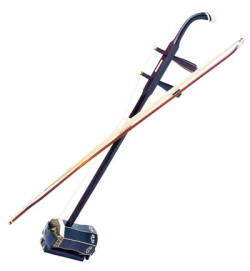Chinese Culture >> Chinese Society, Traditions >> Erhu
Erhu: Chinese Violin
The erhu (Chinese: 二胡),
sometimes known in the West as the 'Chinese violin' or Chinese two string
fiddle, is a two-stringed bowed musical instrument, used as a solo instrument as
well as in small ensembles and large orchestras. It belongs to the huqin family
of bowed string Chinese instruments, together with the zhonghu (中胡), gaohu (高胡),
banhu (板胡), jinghu (京胡), sihu (四胡), and numerous others. (![]() Click
here to watch video of erhu being played)
Click
here to watch video of erhu being played)
 The
erhu can be traced back to instruments introduced into China more than a
thousand years ago. It is believed to have evolved from the xiqin (奚琴), which
was described as a foreign, two-stringed lute in an encyclopedic work on music
by music theorist Chen Yang called Yue Shu (book of music), written
during the Northern Song
Dynasty. The xiqin is believed to have originated from the Xi
people of Central Asia, and have come to
China in the 10th century
The
erhu can be traced back to instruments introduced into China more than a
thousand years ago. It is believed to have evolved from the xiqin (奚琴), which
was described as a foreign, two-stringed lute in an encyclopedic work on music
by music theorist Chen Yang called Yue Shu (book of music), written
during the Northern Song
Dynasty. The xiqin is believed to have originated from the Xi
people of Central Asia, and have come to
China in the 10th century
The first character of the name of the instrument, "二" (èr, meaning "two"), is said to come from the fact that it has two strings; however, it is also said to have come from the fact that it is the second highest "huqin" in pitch to the gaohu "高胡" in the modern chinese orchestra. The second character, "胡" (hú), indicates that it is part of the huqin family. The name huqin literally means "barbarian instrument," showing that the instrument may have originated from regions to the north or west of China.
The erhu consists of a long vertical stick-like neck, at the top of which are two large tuning pegs, and at the bottom is a small resonator body (sound box) which is covered with python skin on the front (playing) end. Two strings are attached from the pegs to the base, and a small loop of string (qian jin) placed around the neck and strings acting as a nut pulls the strings towards the skin, holding a small wooden bridge in place.
Various dense and heavy hardwoods are used in making the erhu. According to Chinese references the woods include zi tan (紫檀 red sandalwood and other woods of the genus pterocarpus such as padauk), lao hong mu (老红木 aged red wood), wu mu (乌木 black wood), and hong mu (红木 red wood). Particularly fine erhus are often made from pieces of old furniture. A typical erhu measures 81cm from top to bottom, the length of the bow is also 81cm.
Erhu Music
A notable composer for the erhu was Liu Tianhua (刘天华/劉天華) (1895-1932), a Chinese musician who studied Western music as well. He composed 47 exercises and 10 solo pieces (1918-32) which were central to the development of the erhu as a solo instrument. His works for the instrument include Yue Ye (Moon Night; 月夜; Pinyin: Yuèyè) and Zhuying Yaohong (Shadows of Candles Flickering Red; 烛影摇红; Pinyin: Zhǔyǐng Yáohóng).
Other solo pieces include Er Quan Ying Yue (Moon Reflected on Second Spring) by A Bing, Sai Ma (Horse Race) by Huang Haihuai, Henan Xiaoqu (Henan folk tune) by Liu Mingyuan, and Sanmenxia Changxiangqu (Sanmen Gorge Rhapsody) by Liu Wenjin. Most solo works are commonly performed with yangqin accompaniment, although pieces such as the 10 solos by Liu Tianhua, and Er Quan Ying Yue originally did not have accompaniment.

In addition to the solo repertoire, the erhu is also one of the main instruments in regional music ensembles such as Jiangnan Sizhu, Chinese opera ensembles, and the modern large Chinese orchestra.
The erhu is also used in the music of the Cirque du Soleil show O.
